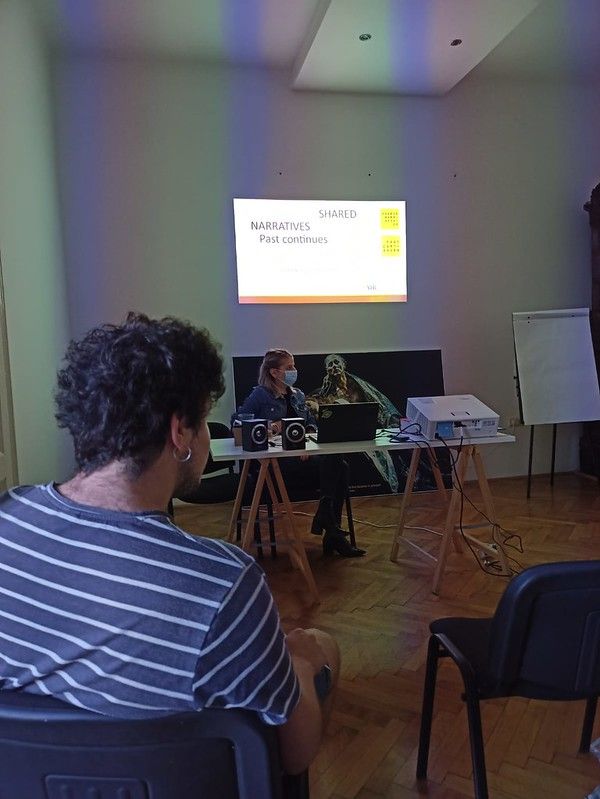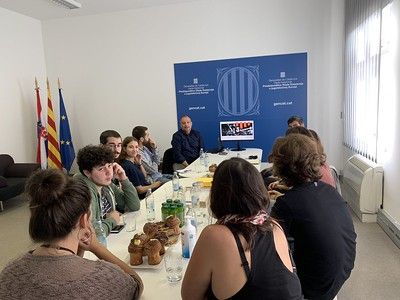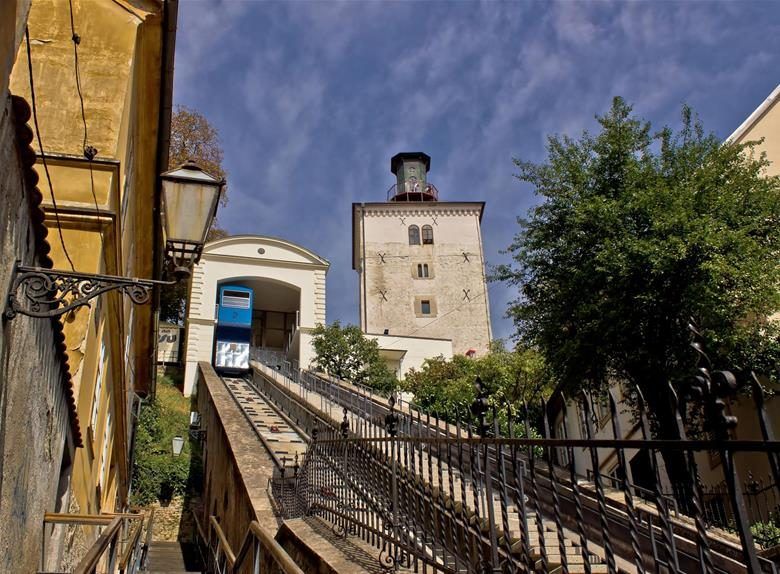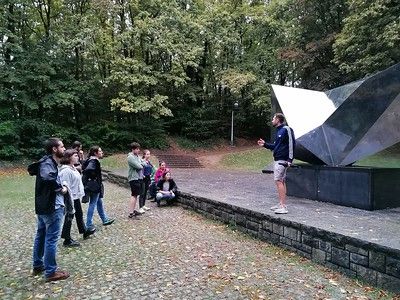DAY 1
September 23rd
The first day started very early as our first flight left Barcelona around 6am. We met at the airport one hour before boarding and we kicked off our trip. It was the first time that all group members were together face to face so we also started meeting each other properly and sharing expectations and opinions about the upcoming days. We took our first flight to Paris, where we did not have much time before boarding our second and last plane of the day, which finally took us to Croatia, the country’s capital airport.
We reached the centre of Zagreb by shuttle bus, which due to a confusion left us further from the hotel than we first anticipated, but we eventually reached Hotel Central after a nice walk through the city. There, each of us was assigned an individual room due to coronavirus-related sanitary precautions, and having left our luggage we went to look for somewhere to have lunch, as part of the group was already vehement about their hunger. We found a nice terrace in a busy street near the city centre, where we had our first Croatian meal, and having rested a little bit we went to the Youth Initiative for Human Rights’ office in the city (henceforth YIHR Croatia), where we held our first activity.

To start with, our colleague Duran presented our project and explained why we were taking the trip and why we thought that we shared interests with YIHR and also gave them some information about our group at large within the CJB and explained how we got there and our previous experiences, study visits and exchanges. Then the organization’s staff shared the session that they had prepared in which they explained to us how they work and the why of it all. YIHR was first founded in Serbia and Kosovo to address its particular conflict but eventually expanded to the current regional size, with offices and activists across five countries, having added Bosnia and Herzegovina, Croatia and Montenegro. After the presentation we engaged in a lot of questions and opinions with our interlocutors as they were extremely collaborative and explanatory but finally the session ended as we would see them again the following day.
Once we had already finished with the first day activities, we all went to have a drink and then dinner. It had been a long day and everybody was a little bit tired, so we went back to the hotel and wrapped up a very busy day.
DAY 2
September 24th
Having overcome an exhausting first day, everyone needed to rest and recover. Fortunately, our faces on Thursday morning were completely different than the day before. We had regained our forces and we were absolutely ready to continue with the historical memory-related activities in the city of Zagreb.
After having breakfast and a badly needed cup of coffee we went back to the headquarters of YIHR Croatia. This time, the team explained us the insights of their most successful campaign “Shared Narratives”[1]. They set forth that having recognised the existence of different narratives about the recent past in the Balkans, “Shared Narratives” which was able to engage a total of 120 youngsters from Croatia, Bosnia and Herzegovina, Kosovo, Serbia and Montenegro in order to contrast the different perspectives and create a shared narrative about the recent conflicts in the region. During this 18-months project, a conference and 12 bilateral study visits were conducted. Therefore, the young adults were able to participate in the construction of a common narrative and actively combat the still present discrimination towards specific ethnic groups in the region. The ultimate goal of the project was to create a common narrative that mixed the different, heterogeneous visions that existed around the numerous conflicts that the Balkans have undergone.

As a result of its originality, “Shared Narratives” was awarded twice by the European Union. According to YIHR, the success of the project lay in not limiting the debate of specific conflicts to YIHR members who represented the parties involved and added third neutral parties in an effort to generate consensus and act as a moderator that can work as a binder of ideas.
After this remarkably interesting presentation, we discussed the particularities of the project and the different strategies to approach young people, which was especially enriching for us. At the same time, this free time moments provided us with the opportunity to get to know each and every one of us better and have a stronger group cohesion.
The next activity of the day brought us to the high part of Zagreb, which was described as the wealthy area of the city according to our guide Sasha. In one of the multiple parks in the city, while surrounded by trees and being constantly beaten by mosquitoes Sasha showed us the house of the former minister of Croatia as an example of the traditional link between power, corruption and impunity. Despite this more political, but not less interesting fact, Sasha designed for us a historical walk to discover different monuments and memory sites in Zagreb. Besides this, he showed us different examples of how street activism can be used to spread historical memory knowledge.

To conclude, the second day in Zagreb was intense and gave us plenty of inspiration of the actions that have taken place in Zagreb which in turn inspired us for the projects that we are attempting to start in Barcelona and from which we might take ideas.
DAY 3
September 25th
Visiting the Catalan Delegation and listening to Eric Hauck experience during the Bosnian War
After a quick breakfast at the Central Hotel, we walked to the Delegation of the Government of Catalonia to the Balkans, at Hebrangova street, where most of the foreign embassies are. There, the journalist and current delegate of Catalan government, Eric Hauck, as well as the other delegation employees were waiting for us. We regretted having breakfast at the hotel, because they offered us an assortment of delicious traditional pastries. We sat around a table where Mr. Hauck told us about the work the delegation is currently doing, by strengthening the commercial, social and cultural links between Catalonia and the Balkans. After this introduction, he explained why the relationship between the Balkans -specially Bosnia and Herzegovina- and Catalonia was so significant and he highlighted the relevance of the 11th Barcelona district.

In the early 90’s, when Barcelona was the Olympic capital and Sarajevo was suffering from the worst siege of contemporary history, the relationship between both cities was boosted by means of cooperation. To avoid bureaucratic obstacles and to make sure that supplies arrived fast enough, Barcelona included another district to its 10, which was Sarajevo. That way, the city council could increase the budget dedicated to cooperation and channel the humanitarian help arriving from all around Catalonia. Indeed, Barcelona City Council wasn’t the only one concerned about what was happening in Bosnia and Herzegovina, but on the contrary, a lot of families in Catalonia provided refuge to Bosnian people and they launched several projects to furnish assistance.
In this respect, Eric Hauck narrated his experience as a correspondent in Sarajevo during the siege. It was really shocking to learn about how they had to hide while working and the terrible conditions in which the civilian population lived. But most stupefying of all, it was really moving to hear about the death of his friend and co-worker, the photographer Jordi Pujol, who passed away in one of the bombardments the city was undergoing at the time.

On the way to the restaurant where we had lunch together, we visited the Grič Tunnel, a pedestrian tunnel located in the city centre which was built during World War II to be used as a bomb shelter and as a promenade. It fell into disuse until the 90’s, when it hosted the first raves in Croatia and served as a bomb shelter for Croatian War of Independence. In 2016, it was reopened to the public as a tourist attraction and to hold some exhibitions and other cultural events.
We were invited by the Catalan Delegation to have lunch at Agava, one of the finest restaurants in Zagreb, where we could taste some of the Croatian traditional meals.
A (rainy) visit to Zagreb’s Antifascist Dotrscina Memorial Park
After having lunch with the team of the Catalan Delegation in the Balkans, and despite the bad weather, we got on the blue tram (lines 12, 5, and 6) to head to our next stop: Zagreb’s Antifascist Dotrscina Memorial Park.
Sasha, the urban memory activist who had led us around the city center the day before, was waiting for us at the entrance of Maksimir Park, which is the oldest -and one of the largest- public parks in Zagreb. After crossing Maksimir, we arrived at our destination. The Memorial is placed in Dotrscina forest, the place where up to 7.000 civilians – mostly Serbs, Jewish, and Roma people- were murdered due to racial, political, and religious discrimination by the nazi-allied Ustashi regime established in 1941.
Soon after Zagreb was liberated, in 1945, locals started to voluntarily memorialise the park by scattering makeshift tombstones in an unorganized way. However, it was not until 1959 when the place was publicly recognized as a site of memory by public authorities. Later on, in 1975, Zagreb was bestowed with the honour of “Hero City” by the Yugoslav government. As a consequence, nine monuments were planned to be constructed at the memorial, however, only 4 were built up eventually since the political upheaval and dismantling of Yugoslavia stopped the Memorial expansion. During the study visit, the group had the chance of visiting some of the constructions which remained completed. In the picture below, you may find the “Monument to the Fallen in Zagreb liberation” by Branzo Ruzic – which has been damaged and restored several times after the 90’s political dismantling of Yugoslavia.

The place was shady and magnificent at the same time, as it preserved most of its forest shape; monuments were sometimes hidden by nature. This is the case of the “Valley of the Graves”, a crystalline sculpture created by Dalina Grobova which intended to mark where massive graves were found after WWII. Apparently, the artist expected to create more sculptures as massive graves were found but that aim was never realised.
After the visit to the Dotrscina memorial, the group had the opportunity to have dinner together with the Catalan delegate once again as well as Vjeran Pavlakovic, teacher of Cultural studies’ in the University of Rijeka. In that informal gathering, we had the opportunity to raise questions, share common experiences, and certainly fostered our understanding of the region’s situation.
DAY 4
September 26th
The last day, we did not have any prepared official activity, so we got up a little later than usual. We had breakfast in a bar near the hotel and took the opportunity to talk about the conclusions that each of us had been able to draw from the trip.
The topics we talked about were framed within different perspective -the logistical perspective, the research about the collective memory of Zagreb, the relationship with the Catalan delegation in the Balkans and our future actions as an entity-. Firstly, from the logistic perspective, reference was made to the difficulty of drawing deep conclusions with only a 4-day trip, despite being aware of how difficult it is to organize a trip of these characteristics while there is a global pandemic. Besides, all of us agreed that we could have programmed quite a few more activities, since we had more free time -unlike the previous year-.
As for the collective memory of Zagreb, one of the most interesting questions to be raised was, from our point of view, that Croatia has a more dominant historical narrative than Bosnia, which is far more fragmented because of its high number of Croatian and Serbian population. In this sense, a complicated challenge for the defence of the collective Croatian memory is to recognise the damage that Croatian nationalism caused in the other nations that participated in the the 1990s war. We also discussed the possibility of developing actions with the support of the Catalan delegation in the Balkans, especially regarding the relationship that can be created between the 11th district of Barcelona and our entity, enabling us to have a direct impact on the collective memory of the Balkans and its relationship with Barcelona.
Once we wrapped out our conclusions, and after separating for the first time in the whole trip during a short time, we went to the upper town of Zagreb, using the funicular railway. This funicular is only 60 meters long and is known as the shortest funicular public transport in the world. It started transporting visitors at the end of the 19th century and, with some breaks, it has ever since been providing that service until today. The idea of Zagreb having a funicular railway, like many other European cities of the time, came after observing that people passed through Tomićeva Street to climb the stairs to get to Upper Town instead of going through Radićeva or Mesnićka Street, which led you there from the main square.

Zagreb’s Funicular Railway
After taking a stroll around the upper town, where we could observe the great process of monumentalization of the city of Zagreb and its relationship with Croatian nationalism, we went for lunch to a restaurant located just below the funicular. Right thereafter, some of us went to buy some souvenirs for our families and friends at the Dolac market, one of the most outstanding tourist attractions in the city, and a few of others went to spend the afternoon in a coffee shop, where we finally met up to go to the hotel and pick up our baggage to head to the airport.


